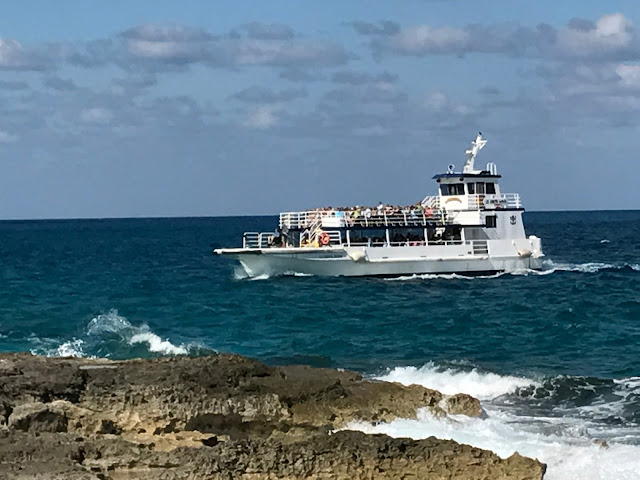Why do Kim and I go on
elaborate, expensive vacations? Why does anyone? It can’t be that these
weeklong excursions make us happy only during the time we spend away, 2% of our
year. It must be that they have a lasting effect, or at least we believe them
to (is there a difference?). Midway through this cruise vacation, I lamented how this
is only fleeting. I can’t make it stick.
I can’t make it last. In just a few short days, it will be gone, and will it
have been worth it? Then I ordered another margarita, watched the sun melt
into the ocean, and went back to living in the moment.
I can’t explain or justify why, in recent years, we’ve been traipsing all over the Caribbean. I’m sure it has something to do with stress reduction, mental health, living life to the fullest, etc. But for Kim and me, there may be another reason. We go on vacation because we still can, and we want to show the world that we still can, and we want to show one another that we still can. But most importantly, I think, we do it because we still enjoy it. We do it to feel alive.
I am still alive.
Kim and I had been to
this tourist mecca before, on our first cruise seven years earlier. We had a
blast that day, but we weren’t sure that the experience would be repeatable.
Back then, it was spur-of-the-moment kind of fun. So we didn’t recommend that
in 2017 the six of us walk into town and randomly bounce around bars until we
got drunk. Instead, we asked the concierge on the cruise for ideas. She
suggested a hotel within walking distance of the pier, which might be a fun
place to hang out for the day.
This time, Tom and Andy volunteered to be the advance team. They found the hotel, confirmed it was wheelchair accessible, and learned it would cost us the enormous sum of $20 per person to hang out by their pool and on their Caribbean beach for the day. Oh, did I mention that included a $12 credit toward lunch? Cozumel is so affordable and so fun.
On the walk from our ship to the hotel, we encountered various vendors. One of them kept repeating the same request to us and our fellow cruisers: “Don’t build that wall.” This is a serious issue to many people on both sides of the border, but we couldn’t help laughing about it several times during the day.
This was our third trip to the enchanted island of
Jamaica. Our ship docked at the relatively obscure port of Falmouth. This time,
Tom and Diane were the advance team. Kim had identified a highly-rated
restaurant on Trip Advisor where we could get authentic Jamaican jerk chicken.
Tom texted us around 8 o’clock to say that he had found the restaurant and it
was wheelchair accessible.
The city of Falmouth has invested in upgrades to the cruise ship terminal. When we stepped off the ship, we were greeted by an almost Disney-like caricature of Jamaica. Modern shops, clean streets, friendly proprietors, curb cuts, accessible public bathrooms, no scary people, no police. We spent an hour or so walking around that area, then it was lunchtime.
When we left the “Green Zone” we encountered the real Jamaica. In their scouting run earlier in the day, Tom and Diane had enlisted the services of a local to guide them through the craziness to the restaurant. The same local approached the six of us as we emerged. For a handful of greenbacks, he led us through the gauntlet of vendors — clothing, memorabilia, drugs — toward the restaurant. I noticed that the seas parted ahead of him. He was a man not to be messed with, and I wondered what he must have done to earn that reputation.
Of course, I was in balance mode in my iBOT, and the natives expressed their amazement. For the first couple of blocks of our walk, there were police officers everywhere. I couldn’t decide if that was more comforting or concerning. When we got further from the port, and the police presence dwindled, I didn’t feel unsafe. The scene can be intimidating in Jamaica, but we were very much their guests, their guests with money to spend.
The restaurant was a hole in the wall. Well, actually, there was no wall. A collection of run down tables and chairs surrounded what looked like an outdoor bar. We sidled up to one table and placed six orders for Jamaican jerk chicken, and a round of RedStripe beer. The chicken was accompanied by local side dishes — rice and vegetables — with optional hot sauce. It tasted amazing.
After devouring the chicken, our guide led us back to Disney-Jamaica. We hung out at Margaritaville another hour, boarded the ship, and set sail for home.
To be continued…
For part 2, click here.
I can’t explain or justify why, in recent years, we’ve been traipsing all over the Caribbean. I’m sure it has something to do with stress reduction, mental health, living life to the fullest, etc. But for Kim and me, there may be another reason. We go on vacation because we still can, and we want to show the world that we still can, and we want to show one another that we still can. But most importantly, I think, we do it because we still enjoy it. We do it to feel alive.
I am still alive.
Cozumel, Mexico
This time, Tom and Andy volunteered to be the advance team. They found the hotel, confirmed it was wheelchair accessible, and learned it would cost us the enormous sum of $20 per person to hang out by their pool and on their Caribbean beach for the day. Oh, did I mention that included a $12 credit toward lunch? Cozumel is so affordable and so fun.
On the walk from our ship to the hotel, we encountered various vendors. One of them kept repeating the same request to us and our fellow cruisers: “Don’t build that wall.” This is a serious issue to many people on both sides of the border, but we couldn’t help laughing about it several times during the day.
Jamaica
The city of Falmouth has invested in upgrades to the cruise ship terminal. When we stepped off the ship, we were greeted by an almost Disney-like caricature of Jamaica. Modern shops, clean streets, friendly proprietors, curb cuts, accessible public bathrooms, no scary people, no police. We spent an hour or so walking around that area, then it was lunchtime.
When we left the “Green Zone” we encountered the real Jamaica. In their scouting run earlier in the day, Tom and Diane had enlisted the services of a local to guide them through the craziness to the restaurant. The same local approached the six of us as we emerged. For a handful of greenbacks, he led us through the gauntlet of vendors — clothing, memorabilia, drugs — toward the restaurant. I noticed that the seas parted ahead of him. He was a man not to be messed with, and I wondered what he must have done to earn that reputation.
Of course, I was in balance mode in my iBOT, and the natives expressed their amazement. For the first couple of blocks of our walk, there were police officers everywhere. I couldn’t decide if that was more comforting or concerning. When we got further from the port, and the police presence dwindled, I didn’t feel unsafe. The scene can be intimidating in Jamaica, but we were very much their guests, their guests with money to spend.
The restaurant was a hole in the wall. Well, actually, there was no wall. A collection of run down tables and chairs surrounded what looked like an outdoor bar. We sidled up to one table and placed six orders for Jamaican jerk chicken, and a round of RedStripe beer. The chicken was accompanied by local side dishes — rice and vegetables — with optional hot sauce. It tasted amazing.
After devouring the chicken, our guide led us back to Disney-Jamaica. We hung out at Margaritaville another hour, boarded the ship, and set sail for home.
For part 4, click here.






















